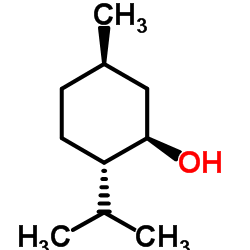1490-04-6
| 中文名 | 薄荷脑 |
|---|---|
| 英文名 | 2-Isopropyl-5-methylcyclohexanol |
| 英文别名 |
(1R,2S,5R)-(−)-Menthol
levo-menthol EINECS 216-074-4 (-)-(1R,3R,4S)-Menthol (−)-menthol (-)-trans-p-Methan-cis-3-ol (1R,2S,5R)-2-Isopropyl-5-methylcyclohexanol Levomenthol L-Menthol (-)-(1R,2S,5R)-Menthol (-)-MENTHYL ALCOHOL (1R)-(-)-Menthol (R)-(-)-Menthol DL-Menthol (1R,2S,5R)-5-methyl-2-propan-2-yl-cyclohexan-1-ol [1R-(1a,2b,5a)]-5-Methyl-2-(1-methylethyl)cyclohexanol (-)-p-Menthan-3-ol Cyclohexanol, 5-methyl-2-(1-methylethyl)-, (1R,2S,5R)- (-)-Menthol UNII:YS08XHA860 Menthol, l- Menthol (1R,2S,5R)-(-)-Menthol MFCD00001484 |
| 描述 | Menthol 是个天然的止痛剂。Menthol 通过抑制神经元细胞膜的 Ca++ 电流,刺激冷感受器,从而产生凉的感觉。 |
|---|---|
| 相关类别 | |
| 参考文献 |
[1]. NicolettaGaleotti, et al. Menthol: a natural analgesic compound. Neuroscience Letters. 2002 Apr. |
| 密度 | 0.9±0.1 g/cm3 |
|---|---|
| 沸点 | 215.4±8.0 °C at 760 mmHg |
| 熔点 | 34-36 ℃(lit.) |
| 分子式 | C10H20O |
| 分子量 | 156.265 |
| 闪点 | 93.3±0.0 °C |
| 精确质量 | 156.151413 |
| PSA | 20.23000 |
| LogP | 3.20 |
| 蒸汽压 | 0.0±0.9 mmHg at 25°C |
| 折射率 | 1.457 |
| 稳定性 | Stable. Combustible. Incompatible with strong oxidizing agents. |
Synonym:p-Menthan-3-o Section 2 - COMPOSITION, INFORMATION ON INGREDIENTS
Risk Phrases: 36/37/38 Section 3 - HAZARDS IDENTIFICATION EMERGENCY OVERVIEW
Irritating to eyes, respiratory system and skin.The toxicological properties of this material have not been fully investigated. Potential Health Effects Eye: May cause eye irritation. The toxicological properties of this material have not been fully investigated. Skin: May cause skin irritation. The toxicological properties of this material have not been fully investigated. Ingestion: May cause gastrointestinal irritation with nausea, vomiting and diarrhea. The toxicological properties of this substance have not been fully investigated. Inhalation: May cause respiratory tract irritation. The toxicological properties of this substance have not been fully investigated. Chronic: Not available. Section 4 - FIRST AID MEASURES Eyes: Flush eyes with plenty of water for at least 15 minutes, occasionally lifting the upper and lower eyelids. Get medical aid immediately. Skin: Get medical aid. Flush skin with plenty of water for at least 15 minutes while removing contaminated clothing and shoes. Ingestion: If victim is conscious and alert, give 2-4 cupfuls of milk or water. Never give anything by mouth to an unconscious person. Get medical aid. Inhalation: Remove from exposure and move to fresh air immediately. If not breathing, give artificial respiration. If breathing is difficult, give oxygen. Get medical aid. Notes to Physician: Section 5 - FIRE FIGHTING MEASURES General Information: As in any fire, wear a self-contained breathing apparatus in pressure-demand, MSHA/NIOSH (approved or equivalent), and full protective gear. During a fire, irritating and highly toxic gases may be generated by thermal decomposition or combustion. Extinguishing Media: Use water fog, dry chemical, carbon dioxide, or regular foam. Section 6 - ACCIDENTAL RELEASE MEASURES General Information: Use proper personal protective equipment as indicated in Section 8. Spills/Leaks: Clean up spills immediately, observing precautions in the Protective Equipment section. Sweep up or absorb material, then place into a suitable clean, dry, closed container for disposal. Section 7 - HANDLING and STORAGE Handling: Wash thoroughly after handling. Remove contaminated clothing and wash before reuse. Use only in a well-ventilated area. Avoid contact with eyes, skin, and clothing. Avoid ingestion and inhalation. Storage: Keep container closed when not in use. Store in a cool, dry, well-ventilated area away from incompatible substances. Section 8 - EXPOSURE CONTROLS, PERSONAL PROTECTION Engineering Controls: Use adequate ventilation to keep airborne concentrations low. Exposure Limits CAS# 1490-04-6: Personal Protective Equipment Eyes: Wear appropriate protective eyeglasses or chemical safety goggles as described by OSHA's eye and face protection regulations in 29 CFR 1910.133 or European Standard EN166. Skin: Wear appropriate protective gloves to prevent skin exposure. Clothing: Wear appropriate protective clothing to prevent skin exposure. Respirators: Follow the OSHA respirator regulations found in 29 CFR 1910.134 or European Standard EN 149. Use a NIOSH/MSHA or European Standard EN 149 approved respirator if exposure limits are exceeded or if irritation or other symptoms are experienced. Section 9 - PHYSICAL AND CHEMICAL PROPERTIES Physical State: Solid Color: white Odor: None reported. pH: Not available. Vapor Pressure: Not available. Viscosity: Not available. Boiling Point: Not available. Freezing/Melting Point: 28.00 - 30.00 deg C Autoignition Temperature: Not available. Flash Point: 93 deg C ( 199.40 deg F) Explosion Limits, lower: Not available. Explosion Limits, upper: Not available. Decomposition Temperature: Solubility in water: soluble in alcohol, chloroform and ether Specific Gravity/Density: .8900g/cm3 Molecular Formula: C10H20O Molecular Weight: 156.27 Section 10 - STABILITY AND REACTIVITY Chemical Stability: Stable under normal temperatures and pressures. Conditions to Avoid: Incompatible materials. Incompatibilities with Other Materials: Strong oxidizing agents. Hazardous Decomposition Products: Carbon monoxide, carbon dioxide. Hazardous Polymerization: Has not been reported. Section 11 - TOXICOLOGICAL INFORMATION RTECS#: CAS# 1490-04-6: GW0554000 LD50/LC50: Not available. Carcinogenicity: DL-Menthol - Not listed by ACGIH, IARC, or NTP. Other: See actual entry in RTECS for complete information. Section 12 - ECOLOGICAL INFORMATION Section 13 - DISPOSAL CONSIDERATIONS Dispose of in a manner consistent with federal, state, and local regulations. Section 14 - TRANSPORT INFORMATION IATA Not regulated as a hazardous material. IMO Not regulated as a hazardous material. RID/ADR Not regulated as a hazardous material. Section 15 - REGULATORY INFORMATION European/International Regulations European Labeling in Accordance with EC Directives Hazard Symbols: XI Risk Phrases: R 36/37/38 Irritating to eyes, respiratory system and skin. Safety Phrases: S 24/25 Avoid contact with skin and eyes. WGK (Water Danger/Protection) CAS# 1490-04-6: 1 Canada CAS# 1490-04-6 is listed on Canada's DSL List. CAS# 1490-04-6 is not listed on Canada's Ingredient Disclosure List. US FEDERAL TSCA CAS# 1490-04-6 is listed on the TSCA inventory. SECTION 16 - ADDITIONAL INFORMATION N/A |
CHEMICAL IDENTIFICATION
|
| 符号 |


GHS05, GHS07 |
|---|---|
| 信号词 | Danger |
| 危害声明 | H315-H318-H335 |
| 警示性声明 | P280-P305 + P351 + P338 + P310 |
| 危害码 (欧洲) | Xn,Xi |
| 风险声明 (欧洲) | 37/38-41-48/20/22-40-22 |
| 安全声明 (欧洲) | 36/37/39-36-26 |
| 危险品运输编码 | UN 1888 6.1/PG 3 |
| WGK德国 | 2 |
| RTECS号 | OT0525000 |


